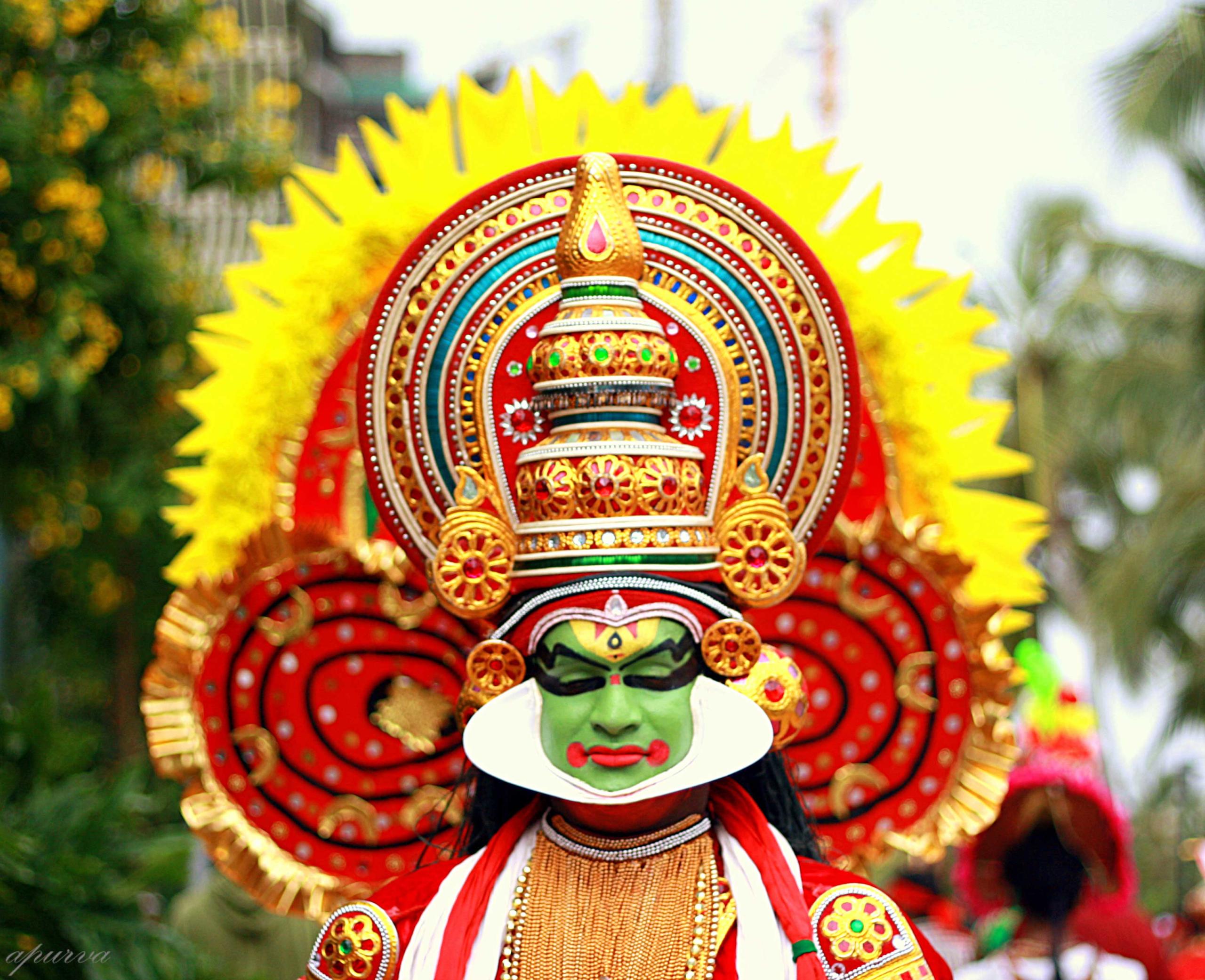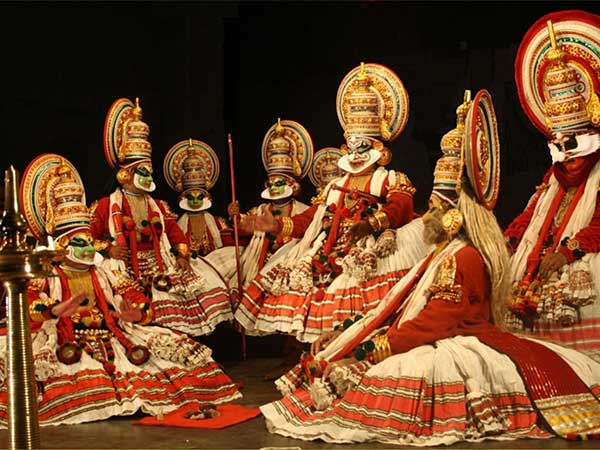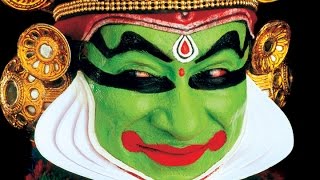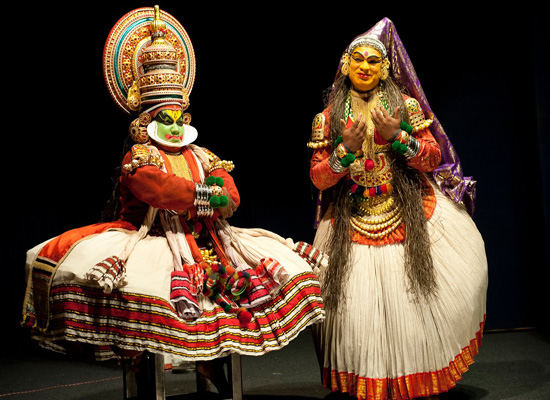Kathakali – Dance and Drama

Kathakali is one of the major forms of Indian classical dances. Developed in the Malayalam-speaking southwestern region of India (Kerala) Kathakali means ‘Story-Play‘ and has been linked to a ballet, a miracle play, a dance-drama, an opera, and a pantomime.
It is distinguished by its elaborately colorful make-up, costumes, and face masks wearing actor-dancers, who have traditionally been all males. A Kathakali performance, like all classical dance arts of India, includes music, vocal performers, hand and facial gestures to express ideas and footwork. However, Kathakali differs in its style and incorporates movements from the ancient martial arts and athletic traditions of south India.
The term Kathakali is derived from Katha which means “story, or a conversation, or a traditional tale“, and Kali which means “performance and art“.
Origin
Kathakali has its origins almost 1500 years ago in the early ritual folk dances and dance dramas of Kerala, in southern India, such as the dances associated with the cult of Bhagavathy, that was performed at religious festivals by actors wearing elaborate masks, colorful costumes, and headdresses, and intricately painted faces; and socio-religious and material dances such as the Sastrakali and Ezhamattukali.
Around the seventeenth century, acting became separated from singing, leaving the actors free to concentrate on dramatic expression. In the eighteenth century, Kapplingattu Nampoothiri introduced a number of innovations that shaped Kathakali as it is performed today. He improved the percussion accompaniment and standardized the use of alarrca, the inarticulate cries made by demons and animals.
Elements of the art of Kathakali are discernible in the ancient ritual plays of Hindu temples and various dance form that is believed to have been gradually developed in Kerala from as early as the 2nd century until the end of the 16th century.
The elements and aspects of Kathakali can be found in ancient Sanskrit texts such as the Natya Shastra. Maximum Indian classical dancers believe that Natyasastra is an authentic book of commandment and methodology of the dance to which they represent or belong. But factually Natyassasta is a manuscript on dramaturgy.
The text, states Natalia Lidova, describes the theory of Tandava dance (Shiva), the theory of rasa, or bhava, expression, gestures, acting techniques, basic steps, standing postures – all of which are part of Indian classical dances including Kathakali.
Kathakali, as it is performed today, is just more than four centuries old. It is no longer restricted to temples, palaces, and religious festivals, but is often presented in theaters and at special events as entertainment, and is performed far more frequently than the older forms of dance-drama to which it is related.
Kathakali Plays

According to tradition, there are 101 classical Kathakali stories, though less than a third of these are commonly staged at present. Some of the popular stories enacted are Nalacharitham (a story from the Mahabharata), Duryodhana Vadham (focusing on the Mahabharata war after profiling the build-up to it), Kalyanasougandhikam, (the story of Bhima going to get flowers for his wife Panchali), Keechakavadham (another story of Bhima and Panchali, but this time during their stint in disguise), Kiratham (Arjuna and Lord Shiva’s fight, from the Mahabharata), Karnashapatham (another story from the Mahabharata), Nizhalkuthu and Bhadrakalivijayam authored byPannisseri Nanu Pillai.
Also staged frequently include stories like Kuchelavrittam, Santanagopalam, Balivijayam, Dakshayagam, Rugminiswayamvaram, Kalakeyavadham, Kirmeeravadham, Bakavadham, Poothanamoksham, Subhadraharanam, Balivadham, Rugmangadacharitam, Ravanolbhavam, Narakasuravadham, Uttaras wayamvaram, Harishchandracharitam, Kacha-Devayani, and Kamsavadham. Recently, as part of attempts to further popularise the art, stories from other cultures and mythologies, such as those of Mary Magdalene from the Bible, Homer’s Iliad, and William Shakespeare’s King Lear and Julius Caesar beside Goethe’s Faust too have been adapted into Kathakali scripts and on to its stage.
Costumes

Of all classical Indian dances, Kathakali has the most elaborate make-up code, headdress, face masks, and vividly painted faces. It typically takes several evening hours to prepare a Kathakali troupe to get ready for a play.
The makeup follows an accepted code, that helps the audience easily identify the archetypical characters such as gods, goddesses, demons, demonesses, saints, animals, and characters of a story. Seven basic makeups are used in Kathakali, namely Pacca (green), Payuppu (ripe), Katti(knife), Kari, Tati, Minukku, and Teppu. These vary with the styles and the predominant colors made from rice paste and vegetable colors that are applied to the face. Pachcha (green) with lips painted brilliant coral red portrays noble characters and sages such as Krishna, Vishnu, Rama, Shiva, Surya, Yudhishthira, Arjuna, Nala, and philosopher-kings.
Tati (red) is the code for someone with an evil streak such as Ravana, Dushasana, and Hiranyakashipu. Some characters have a green face (representing heroic or excellence as a warrior) with red dots or lines on their cheeks or red-colored mustache or red-streaked beard (representing evil inner nature), while others have a full face and beard colored red, the latter implying excessively evil characters. Kari (black) is the code for forest dwellers, hunters, and middle ground characters. Demonesses and treacherous characters are also painted black but with streaks or patches of red.
Yellow is the code for monks, mendicants, and women. Minukka (radiant, shining) with a warm yellow, orange, or saffron typifies noble, virtuous feminine characters such as Sita, Panchali, and Mohini.
Vella Thadi (white beard) represents a divine being, someone with a virtuous inner state and consciousness such as Hanuman. Teppu is for special characters found in Hindu mythologies, such as Garuda, Jatayu, and Hamsa who act as messengers or carriers but do not fit the other categories.
Acting

Kathakali actor uses immense concentration, skill, and physical stamina, gained from regimented training based on Kalaripayattu, the ancient martial art of Kerala, to prepare for his demanding role. In Kathakali, the story is enacted purely by the movements of the hands (called mudras or hand gestures) and by facial 35 expressions (rasas) and bodily movements.
Sequence
Traditional performance in Kerala begins at 8 pm and goes on until dawn. It is preceded at unset by the Kelikottu, when the silence of the evening is broken by the sound of the two drums, played in the open air near the place where the night’s performance is to take place. This tells the local people that there is a Kathakali show on that night.
The repertoire includes a series of performances. First come the Totayam and Puruppatu performances, which are preliminary ‘pure’ (abstract) dances that emphasize skill and pure motion. Totayam is performed behind a curtain and without all the costumes, while Puruppatu is the prelim when it is performed without the curtain and in full costumes.
The expressive part of the performance, which constitutes the play being choreographed as dance-drama, are four: Kalasam (major and most common), Iratti (special, used with battles-related Cempata rhythm), Tonkaram (similar to Iratti but different music), and Nalamiratti (used for exits or link between the chapters of the play).
The characters enter the Kathakali stage in ways that are not found in many major classical Indian dance traditions. Kathakali engages several methods: direct without special effects or curtain; through the audience, a method that engages the audience, led by torchbearers since Kathakali is typically a night performance; tease and suspense called nokku or tirassila or tiranokku, where the character is slowly revealed by the use of a curtain. The “tease” method is typically used for characters with hidden, dangerous intentions.
Suggested Read: Regional Folk Dances of India






